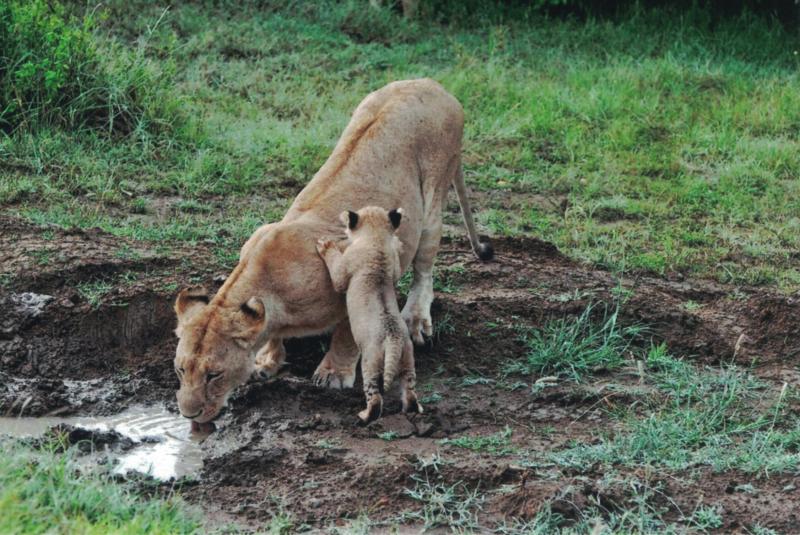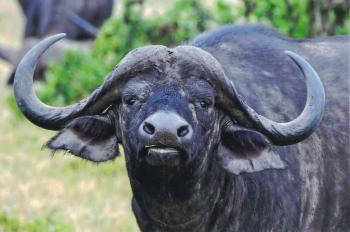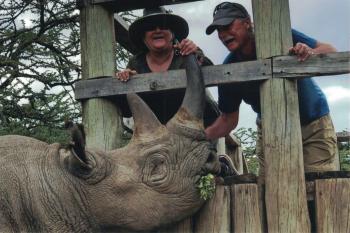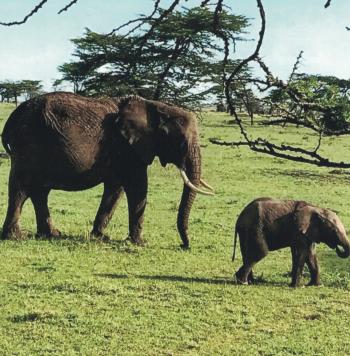A spectacular Kenyan safari
This article appears on page 22 of the December 2019 issue.
Having taken two previous safaris (one in South Africa and one in Botswana and Zimbabwe) that were planned by Rothschild Safaris (Denver, CO; 800/405-9463, www.rothschildsafaris.com), as my wife, Marie, and I began to think of traveling to Kenya, we knew we would once again use Leora and her team to plan our January 2019 trip because of the personalized service we could expect.
We booked the international air travel, with upgrades, independently by using Delta SkyMiles and Capital One points, so the exact price of our flights is somewhat nebulous.
Nairobi
We arrived in Nairobi late in the evening following a 26-hour journey from Louisville to Atlanta to Amsterdam to Nairobi via Delta and KLM. We had arranged to stay overnight at the Four Points by Sheraton (four-points.marriott.com), adjacent to the Jomo Kenyatta International Airport, and representatives of Rothschild met us as we deplaned, whisking us through security and Customs and on to the hotel.
The Four Points was an excellent place for an overnight stay because of its location, a comfortable bed, a 24-hour restaurant and an expansive and good breakfast, all at a reasonable price ($144).
We had wanted to spend several days in Nairobi to experience some of the cultural aspects of the city, so we left the airport hotel late morning to go to Ololo Safari Lodge (phone +254 [0] 708 844 818, www.olololodge.com), on the edge of Nairobi National Park. There, we met up with our travel friends, David and Nancy Holland from Midland, Texas. After a leisurely lunch, we perused the gardens and relaxed by the pool while getting settled in.
Ololo has a variety of accommodations, and we enjoyed our tented cottage. Craig and JoAnna, the Australian owners, were gracious hosts, sharing ideas of things to do in Nairobi and on their premises.
The only negative was that the property seemed to be in the flight path of an airport, and planes could be heard throughout the night, so take earplugs if you’re a light sleeper.
The next day we had a number of things planned in the Nairobi area. For history buffs, the Karen Blixen Museum is worth a visit. For culture fans, the Kazuri Bead Factory (www.kazuri.com) is a must. (Do the tour to see how this cottage industry was started and how it has impacted so many lives.)
Animal lovers will enjoy both the Giraffe Centre (www.giraffecentre.org) and the Sheldrick Wildlife Trust (www.sheldrickwildlifetrust.org).
At the Giraffe Centre, visitors can see Rothschild giraffes munching on acacia leaves in their natural environment and also feed them.
The Sheldrick Wildlife Trust, which has a very successful rescue-and-rehabilitation program for orphaned elephants (and other animals), offered us the opportunity to visit in the afternoon as the elephants were brought back from their day in the bush by their handlers.
It was an incredible experience to be so close to them as they were fed and taken care of by their handlers, who were with them 24/7.
On safari
We chose to visit three different conservancies over the next nine days, staying in a Kicheche (www.kicheche.com) property at each. There can be advantages and disadvantages to using one brand for accommodations, but this is where working with a company you know and trust pays off. We enjoyed all three of the properties.
Kicheche Laikipia, in the Ol Pejeta Conservancy, was a 45-minute flight from Nairobi. Their six tented suites were all very spacious and luxurious, and the food was excellent and prepared fresh for each meal. Buffet lunches were served al fresco in a gazebo-like structure overlooking the water hole, and dinners were plated and always served in the lounge area.
All drinks and laundry service were included at this and the other camps.
Conservancies are typically on the outer edges of national parks and have their own guidelines. In the parts of Kenya where we were, the number of vehicles at any one animal sighting on the conservancy was limited to four or five. In the national parks, there were no restrictions. So, for us, staying in a conservancy — where the number of lodges was also limited — was about seeing the animals rather than other vehicles and people.
Our typical day varied from camp to camp, but at the places where we stayed on this safari, it began between 5:30 and 6, when the kitchen staff brought coffee or tea (determined by our requests the night before) and biscuits/cookies.
The first game drive started around 6:30, a time when the sun was rising and the animals were stirring. We might see a chase, perhaps a kill, or possibly intermixed groups of zebras and wildebeests, elephants and giraffes or assorted antelope and various cats and birds. Regardless, it was always exciting and invigorating.
Sometime between 9 and 10, the breakfast stop was made. A spread was set out that included fresh fruit and juices; various breads, honey and jams; different egg dishes, and the best muesli and yogurt we’ve ever had. The site might be a plateau overlooking the plains, a spot by a river or stream, or a knoll where we’d recently seen a wealth of animals. Regardless, while we were eating and relaxing, we couldn’t let our guard down or we’d miss more of why we’d gone to Africa.
Peter was our guide at Laikipia and, as most guides, was a virtual encyclopedia of knowledge of birds and animals and their footprints and habits. In many cases, he even knew the individual animals.
The guides had all gone through training for over a year, and each had between 13 and 20 years of experience.
Following breakfast, we’d complete our morning drive, then go back to camp to rest, read and relax until the 1 o’clock lunch. After lunch, there was more downtime — time to have a massage or simply to snooze. After all, in the heat of the day, most of the animals were doing the same thing.
Tea was served around 3:30, followed by an afternoon game drive. Along with seeing the animals, a favorite part of this drive was the time for sundowners!
While drinks and snacks were being set up, we’d prepare for the breathtaking African sunset. The acacia trees and the animals framed by the setting sun was beauty personified.
Arriving back at the camp, dinner, drinks and conversation with guests from all over the world began at around 8, continuing as long as people wished to stay awake. However, bed, with a hot-water bottle nestled at the foot, beckoned.
Among our favorite animal sightings at Laikipia was a lone elephant who seemed to parade in front of our tent every day around noon for a couple hours. She seemed to want to put on a show just for us, allowing plenty of photo ops and selfies with her always in the background.
A crash of rhinos with a baby amongst them was also special. And no visit to this area would be complete without a visit to the Ol Pejeta Conservancy (www.olpejetaconservancy.org) to see the only two remaining northern white rhinos in the world. James, the keeper, was so eloquently passionate about the need for conservation and ending poaching. The time spent there was both sobering and inspiring.
Finally, many videos and photos were taken as we watched a cheetah and her four 8-month-old cubs running and chasing each other.
When we prepared to leave Laikipia, a stately giraffe and several elephants with their calves hovered in the area as we loaded our luggage, seemingly bidding us farewell.
The Maasai Mara
We flew south to the Naboisho Conservancy for a stay at the Kicheche Valley camp in the Maasai Mara. This camp was very similar to Laikipia in that there were also six tented suites and a beautiful central area with comfortable furniture and great books on the wildlife and customs of Kenya.
Fellow visitors from the UK and Australia gathered to share the adventures of their day and places in their home areas we all should visit.
Johnson, our guide, seemed to have a special knack for finding baby animals, one of the reasons we selected this time of the year to travel.
One evening we came across three lionesses, each with three cubs between 4 and 8 months old. For over an hour we sat and watched them, some coming as close as 3 or 4 feet from the vehicle. We had our sundowners in the vehicle that day in order to continue enjoying the drama of the animals in their environment.
Another day, we visited a Maasai village and enjoyed a welcoming ceremony, saw how they started fire and made crafts, went into their homes and purchased handmade beads, belts and other gifts.
Despite what is reported about occasional terrorist activity in parts of East Africa, we encountered warm and beautiful people throughout the country.
We also did a walking safari one morning and saw our largest tower of giraffes, at least 19.
While we never saw a direct kill, we did witness a cheetah and cub stalking some gazelles until a confusion of guinea fowl alerted the gazelles that they were being followed. We also observed a lion feasting on the carcass of a giraffe while vultures and hyenas waited in the background, ready to partake in whatever remained.
Another time, we saw a zebra so recently killed that steam was still rising from it. It was the centerpiece for two lionesses teaching their two cubs how to attack and eat this delicacy.
While seeing a kill is not pleasant, it is part of the rhythm of life on safari.
Looking for leopards
After three days at the Valley camp, we continued to our final destination, the Kicheche Bush camp in the Olare Motorogi Conservancy. While it was similar to the other Kicheche camps, the one major difference there was that the showers were bucket showers rather than regular ones. Never fear, though! Buckets of hot water were put in the outdoor tank whenever we wanted, so these showers didn’t seem much different than the others.
The food, again, was prepared with the freshest of ingredients. Lunches were served outdoors, and dinners were eaten by candlelight.
It was at this camp that we had great views of the elusive leopard. Whether on the ground or in the trees, these animals were spectacular to watch. Our guide, Vinny, was excellent at finding the best spots for sightings. It was also here that we had the good fortune to see three lionesses who, the day before, had taken their cubs out of their den for the first time, moving them to a place more accessible. What fun it was to watch these eight cubs tumbling and playing with sticks and each other, climbing clumsily on their mothers and exploring the big world for the first time!
Alas, all good things must come to an end, and our time in Kenya would soon conclude. Our friends’ flight and ours were at different times, so we had a final morning drive before David and Nancy departed. On this drive we saw a “mini migration” of zebras crossing a small river. Watching several hundred of these beautiful animals come to the precipice of a small cliff and decide on their route into the water was special. Some chose the gentle slope, while others chose to jump straight in. Regardless, all gracefully forded the water and came out on the other side ready to take on a new environment, many galloping across the plains with grace and beauty while others lingered along the shore to watch the rest of the dazzle slowly make their way out of the water.
Returning to Nairobi after lunch, we were met by Peter, whom we had met when we first arrived in Nairobi. That evening, Peter took us to an excellent restaurant, The Talisman (320 Ngong Rd.; thetalismanrestaurant.com), before depositing us at the international airport for our trip home.
Rothschild Safaris, as stated earlier, did an excellent job planning and fulfilling our dreams. Leora and her team (Ruthie and Kimberly, in our case) answered every question, made practical suggestions and worked out every detail to perfection. We have now done three safaris with them and will assuredly plan our fourth with this team, whether it will be back to our favorite destination of Kenya or to new areas in Zambia and Malawi or farther afield in Namibia.
The total cost of our time in Kenya (including accommodations, game drives, food and drink, laundry, specially planned excursions and internal air) was approximately $7,000 per person. International air, tips and a few excursions (like the visit to the Maasai village) cost extra.
This was a special trip. Dream big. Dream Kenya!




